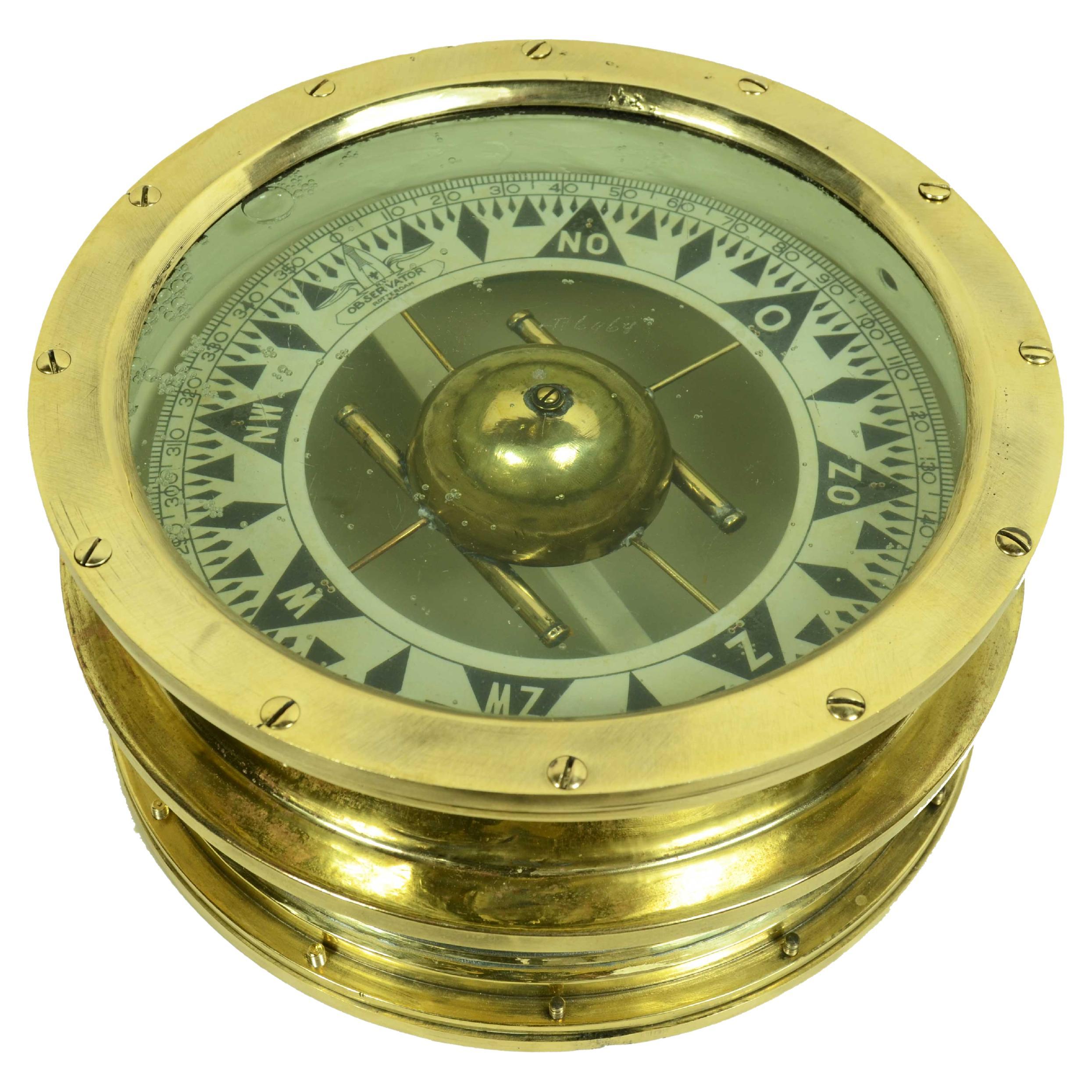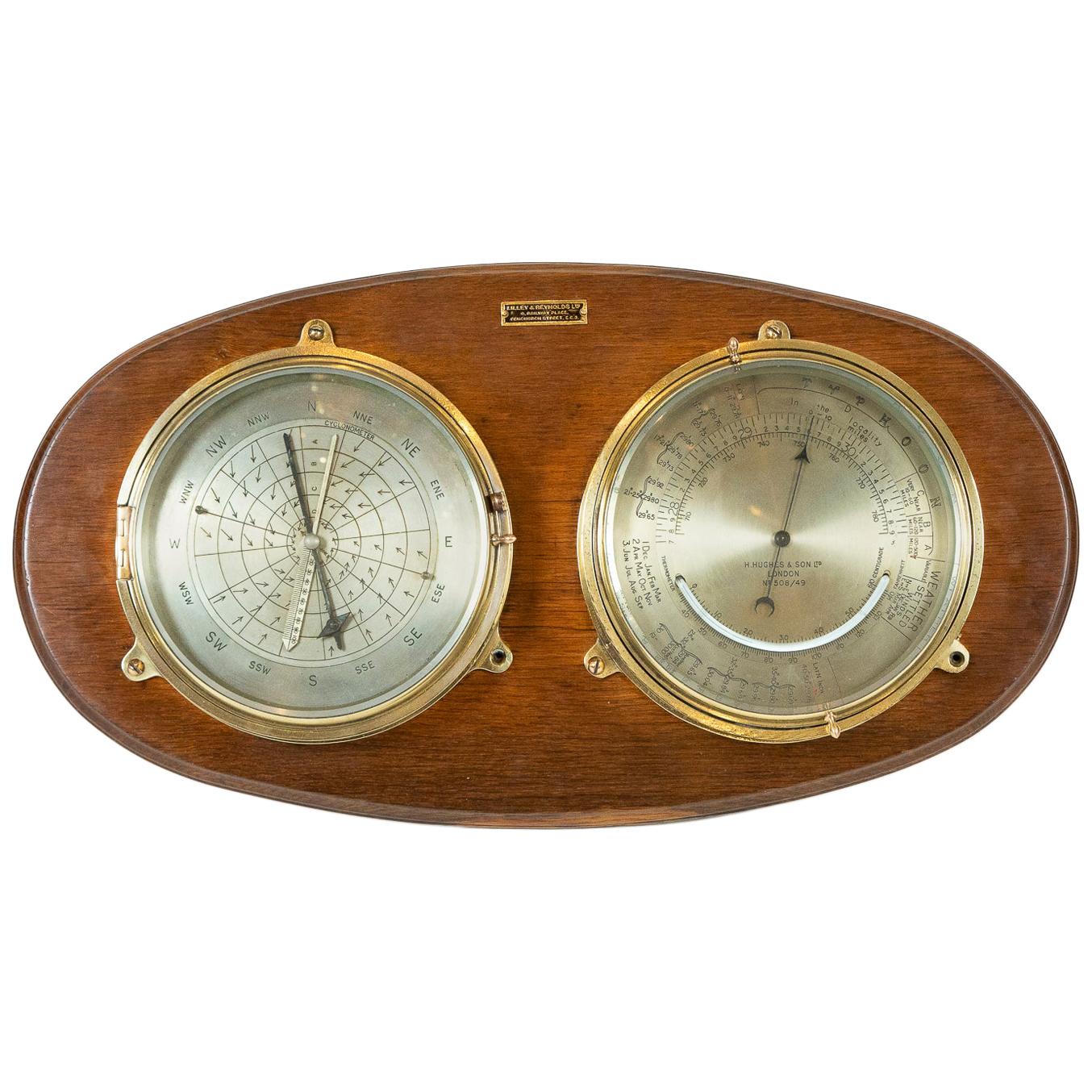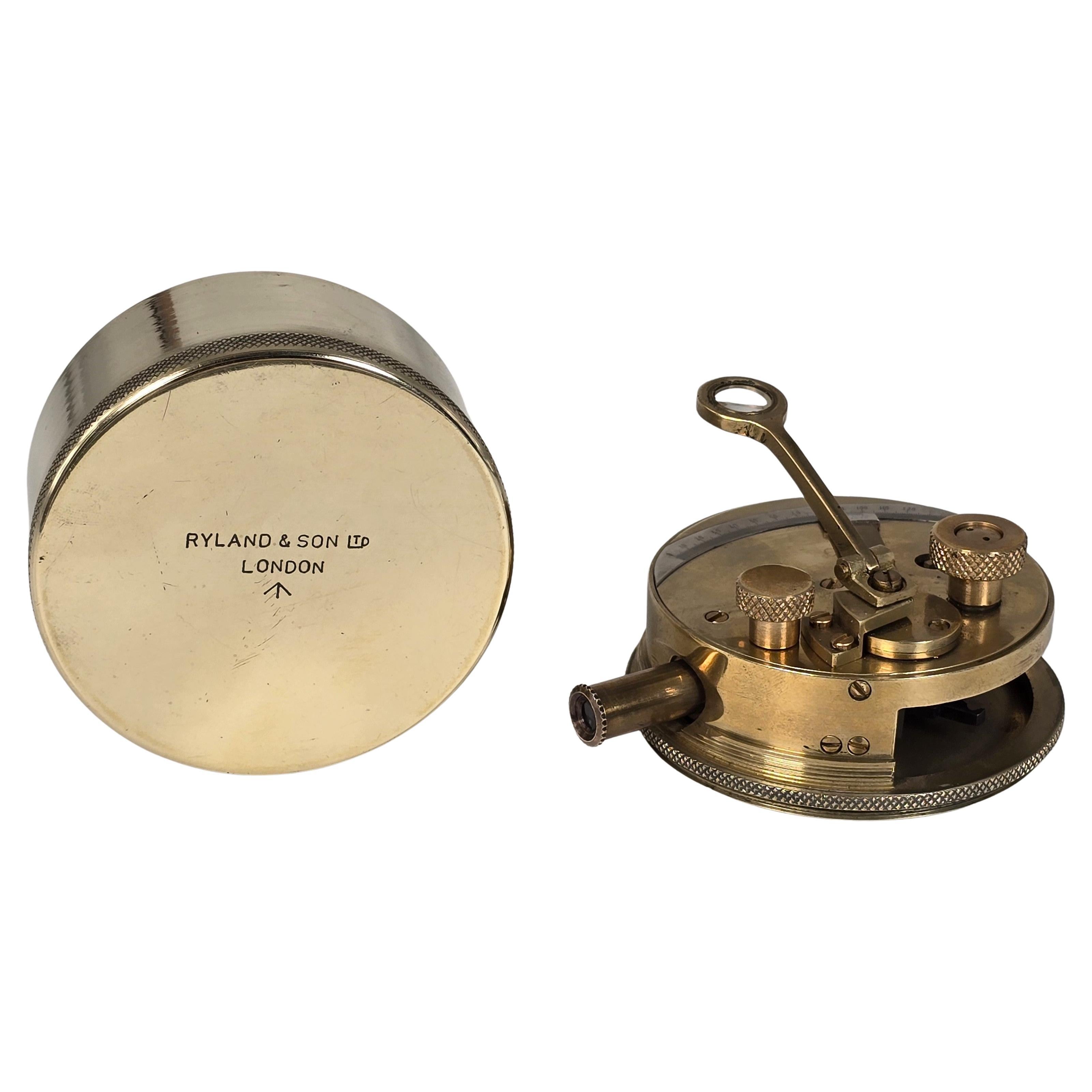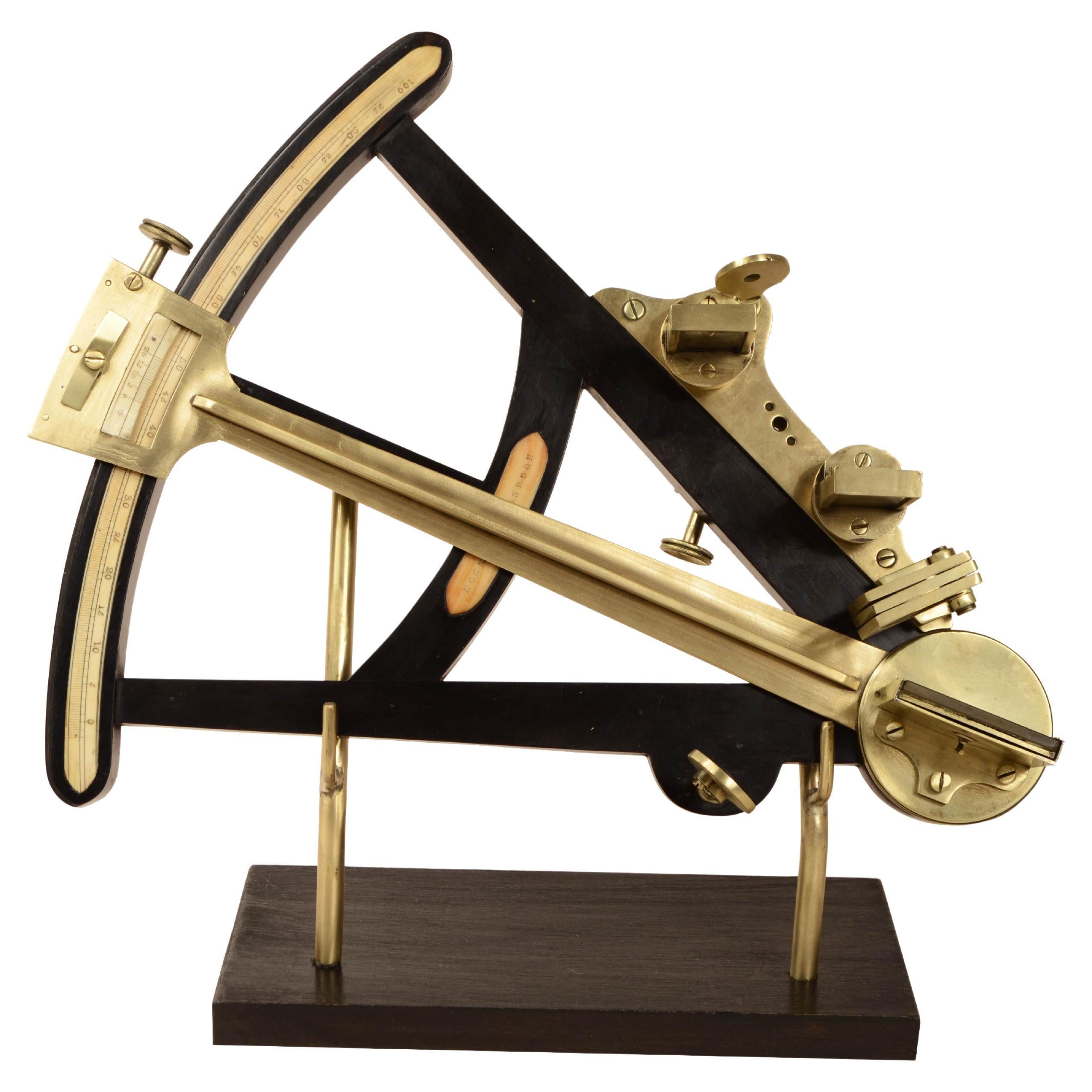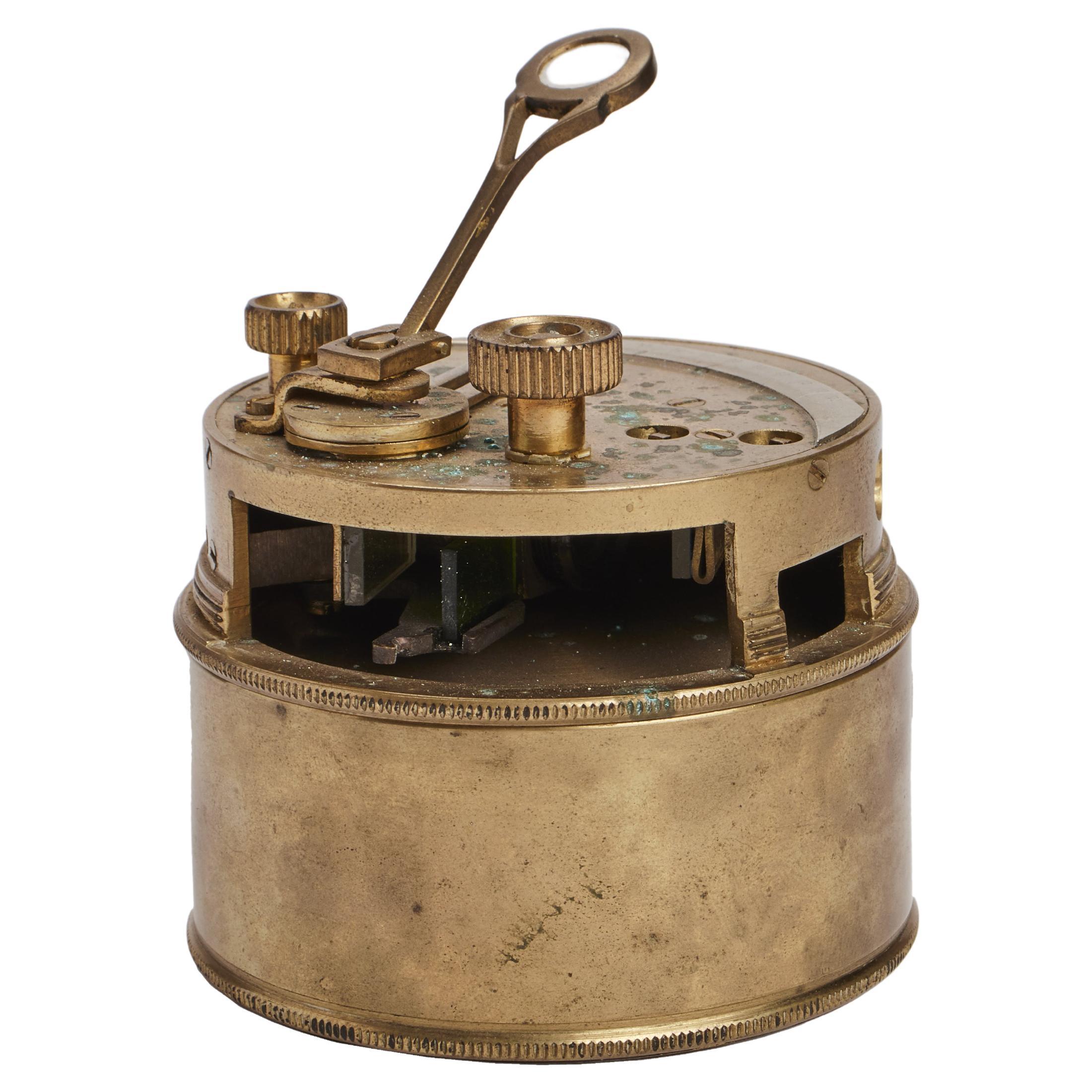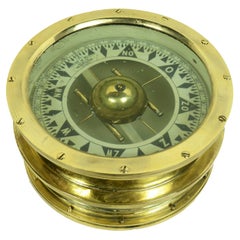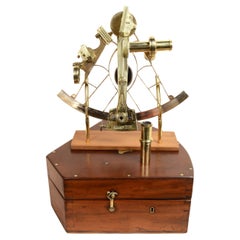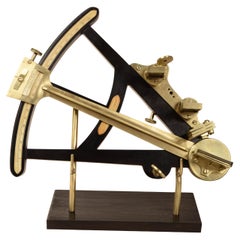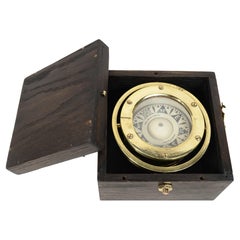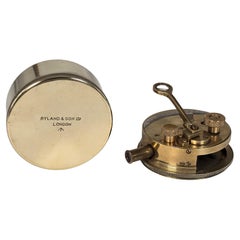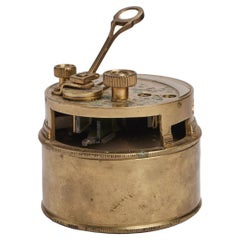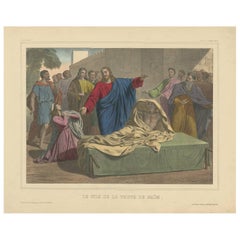Items Similar to Brass sextant signed H. Hughes & Son Ltd No. 32890 of the 1930s
Want more images or videos?
Request additional images or videos from the seller
1 of 21
Brass sextant signed H. Hughes & Son Ltd No. 32890 of the 1930s
About the Item
Brass sextant signed H. Hughes & Son Ltd No. 32890 of the 1930s; instrument complete with optics and housed in its original mahogany wood box of with locking hooks and brass handle, complete with key lock. Brass frame with engraved silver goniometer scale recessed in the arch, with scale from 0 to + 130°, micrometer-adjustable screw-down vernier with built-in illumination and reading nonius, ebonite handle containing batteries for night lighting.
Four colored glasses for the fixed mirror and three for the movable mirror, index and 'horizon mirror, three telescopes, one of which is long, adjustment key and a filter.
Box size 26x27.3x14.5 cm - inches 10.2x10.8x5.4
Conservation status: good fully functional and complete with stand base made of custom wood and brass.
The last photo is the gift box.
The firm founded by Henry Hughes around 1830 became H. Hughes & Son in 1875, and H. Hughes & Son Ltd in 1903. After merging in 1947 with Kelvin, Bottomley & Baird Ltd, the firm became Kelvin & Hughes Ltd.
You place the instrument in a vertical plane and, looking through the sighting device, aim at the horizon line visible through the non-silvered half of the fixed mirror. Moving the alidade, with which the mirror is integral, causes the light rays coming from the star and subsequently reflected by the moving mirror and the silvered half of the fixed mirror to be sent back by the latter in the direction of observation: if you look through the aiming device you can see the image of the star, obtained by double reflection, coincide with the horizon line. The height of the astro is expressed by the angle whose value is read on the graduated scale. The filter is used when the star to be looked at is the Sun.
The sextant is an optical instrument used in astronomical navigation to measure the height of the stars on the horizon in order to derive geographical coordinates relative to the ship's point. It is in the shape of a circular sector of 60°, that is, one-sixth of a circumference, hence the name, at the apex of which is pivoted a movable alidade on which is fixed a mirror that rotates with it. On the back of the mirror is a stand with a telescope oriented toward a second mirror, only one half of which is silvered, making it possible to simultaneously observe the sea horizon, in alignment, and the pointed star, whose image is reflected by the mirror attached to the alidade and subsequently by the silvered part of the mirror. By adjusting the position of the index of the alidade, it is possible to collimate the image of the horizon with that of the star and to derive on the graduated scale of the 60° sector the angle between the horizon and the star. To make a sextant measurement of the height of a star (for example, the Sun), one places the instrument in a vertical plane and, looking through the sighting device, aims at the horizon line visible through the unsilvered half of the fixed mirror. Moving the alidade, with which the mirror is integral, causes the light rays coming from the star and subsequently reflected by the moving mirror and the silvered half of the fixed mirror to be sent back by the latter in the direction of observation: if you look through the aiming device, you see the image of the star, obtained by double reflection, coincide with the horizon line. The height of the astro is expressed by the angle whose value is read on the graduated scale. The filter is used when the star to be looked at is the Sun.
Was Sir Isaac Newton who invented the principle of double reflection in navigation instruments, but this research was never published. Subsequently, two men, independently of each other, discovered the sextant around 1730: John Hadley (1682-1744), an English mathematician, and Thomas Godfrey, (1704-1749), an American inventor. But it was not until 1758 that Admiral John Campbell conducted a series of sea trials to test a new method that relied on lunar distance as a means of calculating longitude. This is how the sextant was developed. Initially made of brass, they had scales divided with great precision by mathematicians who built scientific instruments.
About the Seller
4.9
Platinum Seller
Premium sellers with a 4.7+ rating and 24-hour response times
Established in 1999
1stDibs seller since 2014
395 sales on 1stDibs
Typical response time: 3 hours
- ShippingRetrieving quote...Shipping from: Milan, Italy
- Return Policy
Authenticity Guarantee
In the unlikely event there’s an issue with an item’s authenticity, contact us within 1 year for a full refund. DetailsMoney-Back Guarantee
If your item is not as described, is damaged in transit, or does not arrive, contact us within 7 days for a full refund. Details24-Hour Cancellation
You have a 24-hour grace period in which to reconsider your purchase, with no questions asked.Vetted Professional Sellers
Our world-class sellers must adhere to strict standards for service and quality, maintaining the integrity of our listings.Price-Match Guarantee
If you find that a seller listed the same item for a lower price elsewhere, we’ll match it.Trusted Global Delivery
Our best-in-class carrier network provides specialized shipping options worldwide, including custom delivery.More From This Seller
View AllLarge brass nautical compass signed OBSERVATOR Rotterdam of the 1930s
Located in Milan, IT
Large brass liquid compass signed OBSERVATOR Rotterdam from the 1930s. Eight-twenty rose complete with goniometric circle.
Compass diameter cm 21.5 - 8.5 in, height cm 10.5 - 4.1 in...
Category
Vintage 1930s Nautical Objects
Materials
Brass
Brass sextant signed Imray & Son 89 & 102 Minories London mid-19th century
Located in Milan, IT
Brass sextant signed Imray & Son 89 & 102 Minories London, datable to around mid-19th century, instrument housed in its original mahogany box shaped like the instrument with hinges, ...
Category
Antique Mid-19th Century Nautical Objects
Materials
Brass
Ebony, brass octant signed Hughes London made around 1830
Located in Milan, IT
Ebony wood, brass and marine ivory octant, scale from 0° to 100°,signed Hughes London made around 1830.
Good condition, complete with custom-made display base made of wood and brass....
Category
Antique 1830s Nautical Objects
Materials
Wood
Nautical magnetic compass, signed Henry Browne & Son Ltd Barking & London 1880
Located in Milan, IT
Nautical magnetic compass, signed Henry Browne & Son Ltd Barking & London Sestrel Mark from the second half of the 19th century.
Bon état. Housed in its original wooden box and mou...
Category
Antique 1870s Nautical Objects
Materials
Brass
Nautical magnetic compass, signed by Henry Browne & Son Ltd Sestrel 1942.
Located in Milan, IT
Nautical magnetic compass, signed by Henry Browne & Son Ltd Sestrel 1942, Barking & London 1942. Good condition, slight abrasion on compass rose. The compass is mounted on eboni...
Category
Vintage 1940s Nautical Objects
Materials
Brass
1930s Germany Botanical Model of the Lamium Purpureum Flower
Located in Milan, IT
Educational model of the Lamium purpureum L. (false purple nettle) flower made of painted papier mâché with a Bakelite base from the 1930s, German ma...
Category
Vintage 1930s German Scientific Instruments
Materials
Parchment Paper
You May Also Like
Rare Barocyclonometer by Henry Hughes & Son of London
By Henry Hughes and Son Ltd.
Located in London, GB
A rare barocyclonometer by Henry Hughes & Son of London, circa 1920.
Two silvered 7 inches dials mounted on an oval backboard, the left dial is the Northern hemisphere countercloc...
Category
Early 20th Century English Scientific Instruments
Materials
Brass
WW1 brass pocket military sextant made by Ryland & Sons, London circa 1915
Located in Central England, GB
This rare precision instrument is a fine solid brass pocket sextant made for the military by the high-quality instrument makers Ryland & Son Ltd of London. It dates to the early 20th...
Category
Early 20th Century British Edwardian Scientific Instruments
Materials
Brass
A poket sextant signed Stanley, London 1890.
Located in Milan, IT
A travel nautical instrument, sextant, to determine the ship’s position. The cover became the base of it. Signed Stanley, London, England circa 1890.
Category
Antique Late 19th Century English Scientific Instruments
Materials
Brass
Antique Religious Print 'No. 21' The Son of the Widow of Naïm, circa 1840
Located in Langweer, NL
Antique print titled ‘Histoire Sainte, Nouveau Testament, Le Fils de la Veuve de Naïm.’ This plate shows a scene from the New Testament; The Son of the Widow of Naïm.’
This print ...
Category
Antique Mid-19th Century Prints
Materials
Paper
Burnished brass earth globe - Circa 1930s
Located in Linkebeek, BE
Burnished brass earth globe - Circa 1930s
Globe - World map
Measures : 20x18cm H:25cm
Wear consistent with age and use
Category
20th Century Maps
Materials
Brass
Antique School Model from the 1930s
Located in Wien, AT
A math class cuboid with the old lacquer in typical Bauhaus colors and a nice patina.
Category
Mid-20th Century Czech Minimalist Architectural Models
Materials
Iron, Wire
Recently Viewed
View AllMore Ways To Browse
Vintage Astros
Il Sestante
Antique Japanese Carpets
Antique Meissen Patterns
Antique Side Table With Claw Feet
Antique Silver And Glass Jewelry Box
Antique Silver Glass Jewelry Box
Antique Spiral Leg Table
Antique Table 4 Chairs
Arabia 1970
Ashtray Italy Crystal
Barber Poles
Bauhaus Plant Stand
Bench Public Furniture
Birch Dining Chairs Mid Century
Black Lacquer Wall Panels
Bright Yellow Chairs
Cantilever Leather Dining Chairs
